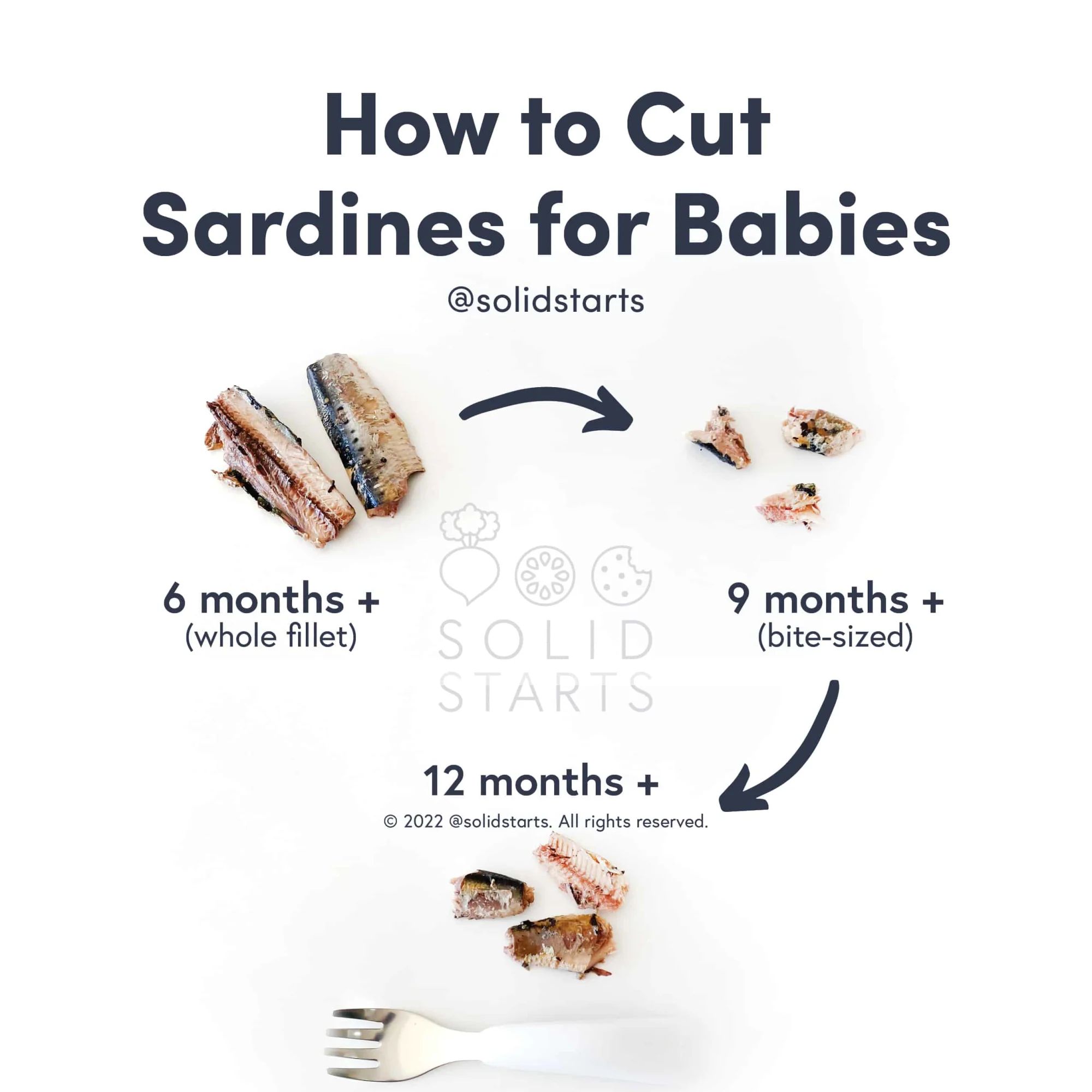Sardines
Fish (Finned)
Age Suggestion
6 months
Iron-Rich
Yes
Common Allergen
Yes

When can babies eat sardines?
Sardines may be introduced as soon as baby is ready to start solids, which is generally around 6 months of age. One of our favorite foods for babies, sardines are low in mercury, high in omega fatty acids, and fantastic alternative to canned tuna.
Recommended Guide: Fish for Babies
What are sardines and where do they live?
Sardines are small forage fish that are a vital food source for humans and oceanic creatures alike. They’re named after the Italian island of Sardinia, where the little silver fish were once abundant, but they’re not native to Italy. The name “sardine” collectively describes multiple species of small forage fish that live in schools in both coastal and deep waters in the world’s oceans. Ever heard of brisling, herring, iwashi, kipper, pilchard, shad, or sprat? Each has unique attributes, but they are all marketed as “sardines” around the world.
Videos
Are sardines healthy for babies?
Yes. Sardines are an excellent food for babies. The tiny oily fishes are one of the top seafood sources of omega-3 fatty acids, including DHA to fuel cardiovascular health, central nervous system development, cell growth, and healthy eyesight. They also are packed with protein, all essential amino acids, and vitamin B12 for healthy blood and neurodevelopment, as well as other B vitamins for energy production. Sardines are among the few naturally-occurring food sources of vitamin D, which babies and toddlers need to grow healthy bones. The fish even offers vitamin E to protect cells, selenium for immune function, iron for healthy blood, and calcium for strong bones.
Sardines get a “best choice” rating in our guide to the Best & Worst Fish for Babies, in part because they are lower in mercury than many other fish species. A general rule of thumb is that the larger the sea animal, the higher the mercury concentration in its body. For example, tuna are large fish and typically high in mercury. Preserved sardines are a fantastic alternative to tuna from pouches or cans.
Sardines are sometimes sold fresh at fish counters, but more commonly are found canned. Some cans might be labeled as “boneless sardines,” which means that the fish’s primary bones have been removed and any remaining bones are tiny and softened by the canning process, making them edible for babies. Some sardines are packaged in brine or marinade containing lots of sodium or sugar, so be sure to read the fine print on the label before purchasing canned sardines, and wait on regularly serving smoked sardines until a child is older.
★Tip: When shopping for canned sardines, look for “low-sodium” or “no salt added” options in BPA-free containers. Brands that fit the bill include Connétable, Crown Prince, King Oscar, Reese, Season Brand, and Wild Planet. Note that Wild Planet sardines still have the backbone (which can be easily removed; see our video on this page for how to prepare).
Are sardines a common choking hazard?
No. Sardines are not a common choking hazard, but fish bones are. Most of the bones in sardine, herring, and other small fish are so tiny that it is impossible for fishmongers to remove them from fresh or frozen herring before sale. Canning softens the bones, making them edible and safe for babies and toddlers to eat. Bones or no bones, make sure to create a safe eating environment and always stay near baby at mealtime, because, in theory, an individual could choke on any food.
Are sardines a common allergen?
Yes. Finned fish are classified as a Global Priority Allergen by the World Health Organization. It is estimated that only 0.2 percent of people are allergic to finned fish worldwide, and the prevalence of fish allergies in children, while variable, is even less than in adults. About 40 percent of people with finned fish allergies don’t experience their first allergic reaction until adulthood. Unfortunately, most individuals who are allergic to finned fish do not outgrow the allergy.
Some individuals with finned fish allergy may react from inhaling airborne proteins that are aerosolized when cooking fish. If this is the case for baby, you may wish to avoid cooking fish in the household when baby is present.
Around 50% of individuals with one finned fish allergy will react to another fish as well. This is because the major allergen in finned fish, beta-parvalbumin, is present in most fish, regardless of species. Due to the risks of cross-contamination or mislabeling, allergists often recommend that those allergic to one species of finned fish avoid all finned fish until meeting with an allergist to determine which fish might be safely introduced into the diet. This is an individualized recommendation, so be sure to confirm with your allergist before offering other finned fish if baby is allergic to sardines.
Finned fish are a known trigger of food protein-induced enterocolitis syndrome, also known as FPIES. FPIES is a delayed allergy to food protein which causes the sudden onset of repetitive vomiting and diarrhea to begin a few hours after ingestion. Left untreated, the reaction can result in significant dehydration. Unlike other food allergens, FPIES to finned fish may not present until later in life, and tends to be life-long.
Lastly, a note on scombroid poisoning, which is sometimes mistaken for a fish allergy. Scombroid poisoning is a type of food poisoning that occurs when someone eats fish that has been improperly refrigerated. This allows a large amount of histamine to build up in the fish. When consumed, this large load of histamine can cause symptoms that mimic those of an allergic reaction, causing some people to believe that they have developed a finned fish allergy, even if they are not allergic. Ensuring that fish has been stored at adequately cool temperatures can minimize the risk of such a reaction.
If you suspect baby may be allergic to fish, consult an allergist before introducing sardines. As with all common allergens, introduce sardines in small amounts at first and watch closely as baby eats to see if any adverse reaction occurs. If all goes well, gradually increase the serving size over time. Once common food allergens are successfully introduced, it is recommended to keep them in the diet regularly (twice weekly, if possible). However, this doesn’t mean that each different fish species must be offered multiple times a week. Finned fish share the same major proteins, so it is perfectly acceptable to rotate finned fish varieties according to availability and preference.
How do you prepare sardines for babies with baby-led weaning?
Every baby develops on their own timeline, and the suggestions on how to cut or prepare particular foods are generalizations for a broad audience.
6 to 9 months old:
Offer whole sardine fillets, cooked and with bones removed, or whole sardines from a can. Canned or packaged sardines can be rinsed under water to remove excess sodium but can be offered with skin and bones still intact, as both are made soft and edible by the canning process. A fillet may be served on its own as finger food or mashed and mixed with soft foods like cooked vegetables, grains, or yogurt for baby to scoop.
9 to 12 months old:
As baby develops the pincer grasp (where the thumb and forefinger meet), try offering a sardine fillet broken into flakes for the child to try to pick up. Alternatively, you can keep serving whole fillets for biting practice.
12 to 24 months old:
Keep offering bite-sized pieces of sardine fillet, either on their own as finger food or as utensil practice. You can also mix the flakes into cooked grains, pastas, or vegetables; pile the flakes on buttered toast, or mix with a dollop of mayonnaise, tahini, or yogurt to encourage hand-scooping or utensil practice. If you are a fan of savory flavors when you wake up, small oily fish like sardines and herring are great additions to the morning routine. Mix flaked sardine into egg dishes, porridge, rice, or mashed avocado on toast.


How to remove the backbone of sardines.
Get a list of foods high in nutrients baby needs with our Nutrient Cheat Sheet.
Written by
Expert Tips Delivered to Your Inbox
Sign up for weekly tips, recipes and more!
The content offered on SolidStarts.com is for informational purposes only. Solidstarts is not engaged in rendering professional advice, whether medical or otherwise, to individual users or their children or families. No content on this site, regardless of date, should ever be used as a substitute for direct medical advice from your doctor or your medical or health professional, nutritionist, or expert in pediatric feeding and eating. By accessing the content on SolidStarts.com, you acknowledge and agree that you are accepting the responsibility for your child’s health and well-being. In return for providing you with an array of content “baby-led weaning” information, you waive any claims that you or your child may have as a result of utilizing the content on SolidStarts.com.










